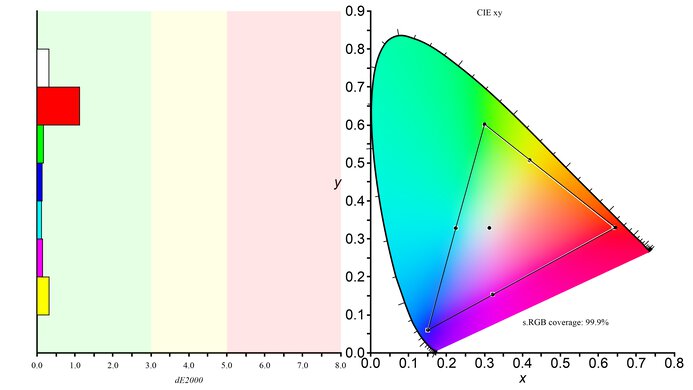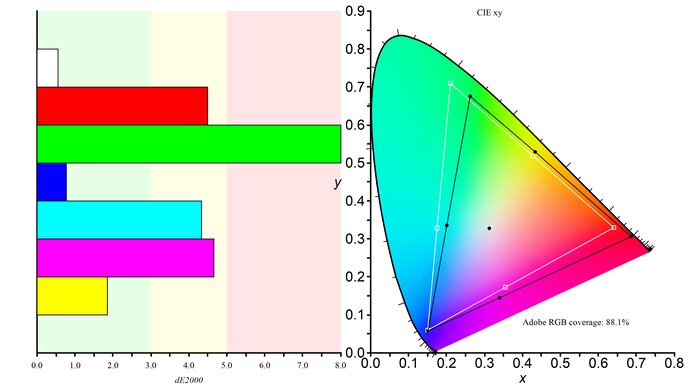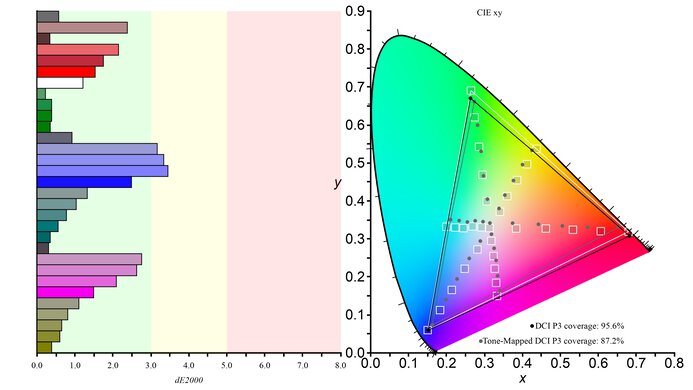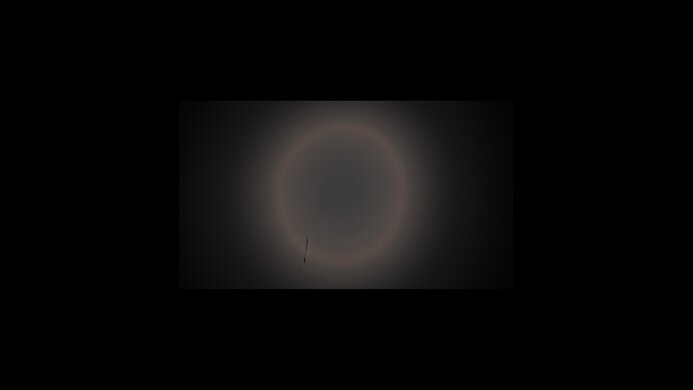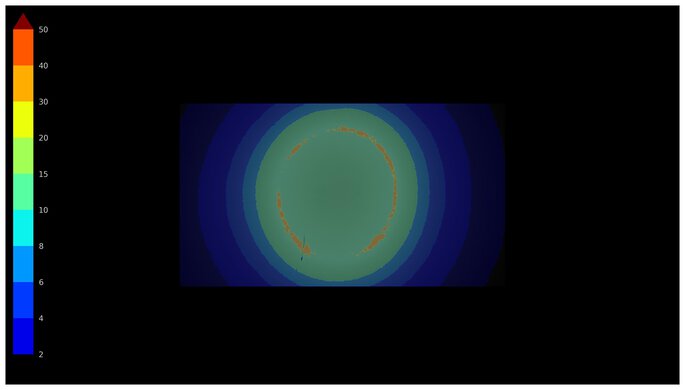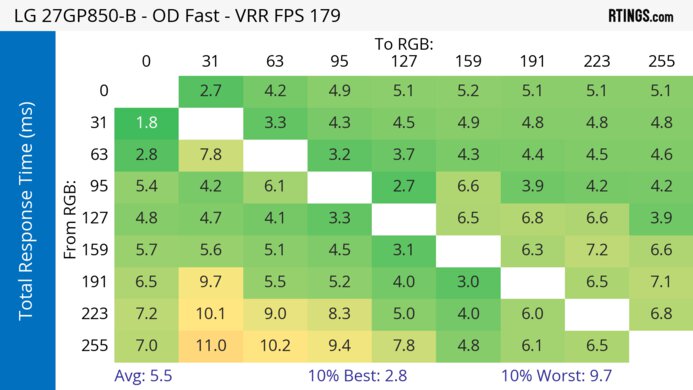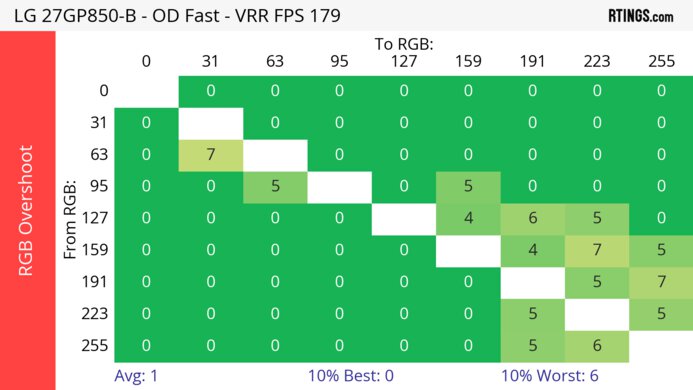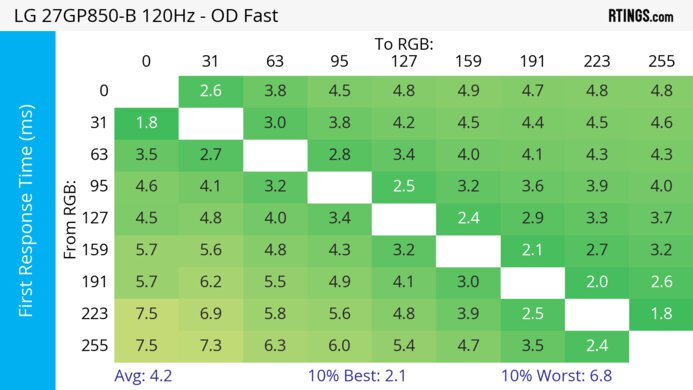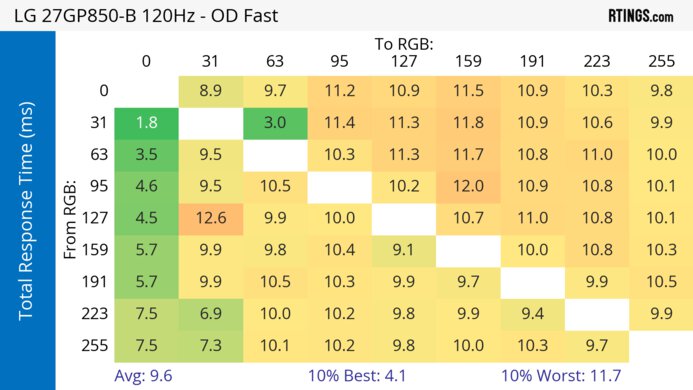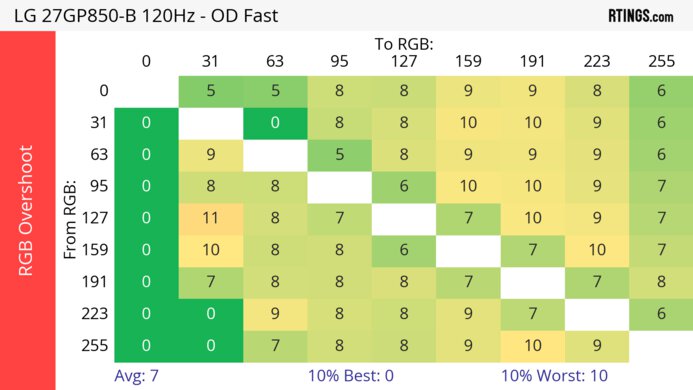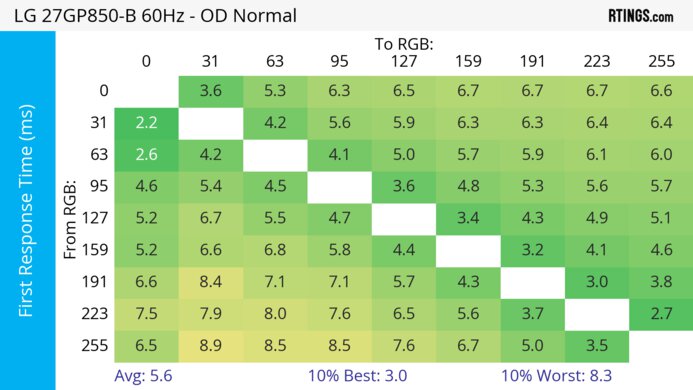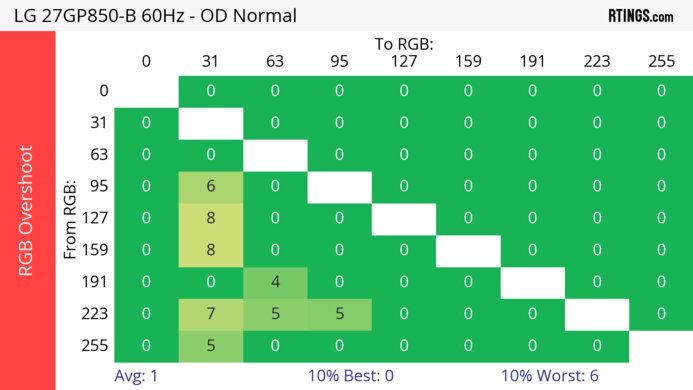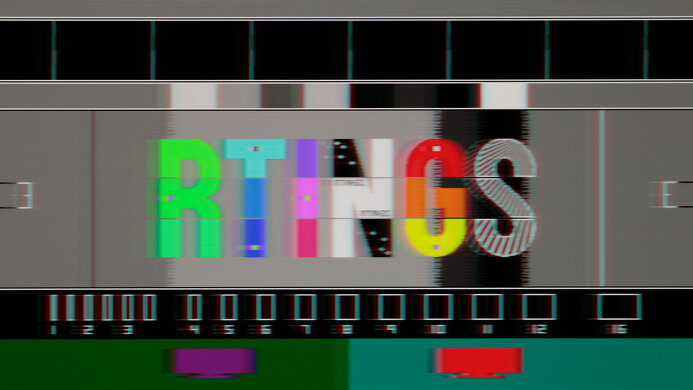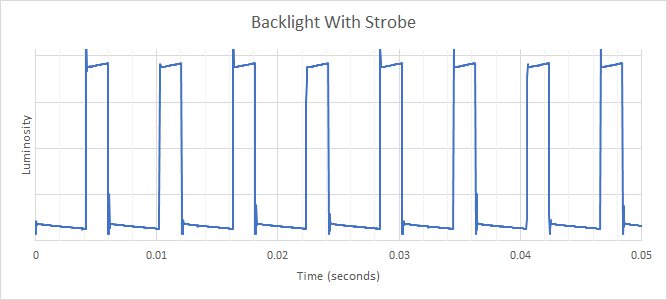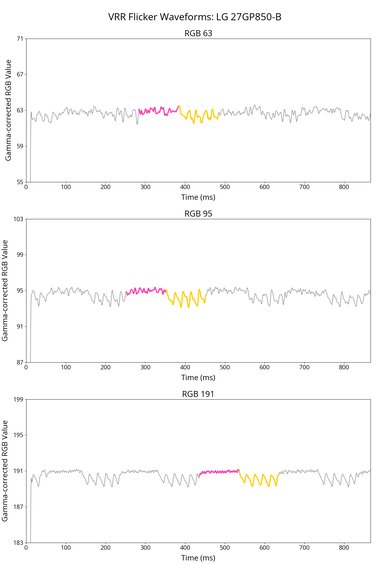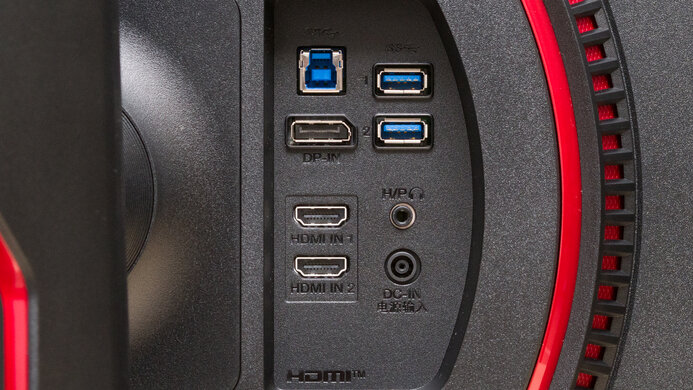The LG 27GP850-B/27GP83B-B is a 27-inch lower mid-range gaming monitor with a 1440p IPS screen. The LG 27GP850-B and LG 27GP83B-B are variants of the same model, but the LG 27GP850-B has extra features like refresh rate overclocking, USB ports, and backlight strobing that the LG 27GP83B lacks. It has a good selection of gaming features, including a native 165Hz refresh rate, FreeSync and G-SYNC-compatible variable refresh rate (VRR) support, and black frame insertion (BFI). It also includes some extra features, like a virtual crosshair, an FPS counter, and a black stabilizer.
Our Verdict
The LG 27GP850-B is a decent PC gaming monitor. Gaming feels responsive and smooth thanks to its low input lag and 180Hz max refresh rate. Motion also looks sharp throughout its entire refresh rate range as it has a fast response time. It has VRR support for FreeSync and is G-SYNC compatible to reduce screen tearing too. However, it doesn't perform well in darker environments and has limited picture quality, as deep blacks appear gray and the screen looks cloudy.
- Great response time across VRR range.
- Low input lag.
- Supports both FreeSync and G-SYNC.
- Low contrast ratio.
- No local dimming.
The LG 27GP850-B is okay for console gaming. It can't take full advantage of the Xbox Series X|S and PS5 as it lacks HDMI 2.1 bandwidth and has a 1440p resolution, but it still works well with the consoles. That said, it offers good gaming performance with a fast response time and low input lag for a responsive feel. Unfortunately, it has limited picture quality, especially in HDR, as it has a low contrast ratio and lacks a local dimming feature to further improve the picture quality.
- Great response time across VRR range.
- Low input lag.
- Low contrast ratio.
- No local dimming.
- Lack of HDMI 2.1 bandwidth.
The LG 27GP850-B is a good choice for an office monitor. It delivers good text clarity and the 27-inch screen has great screen real estate. It overcomes glare in a moderately-lit room, with great peak brightness, but reflections from bright sources are distracting. It displays a wide range of colors in SDR, which is great if your work requires accurate colors, with excellent accuracy before calibration. While it has good overall ergonomics, it doesn't offer any swivel adjustment, making it difficult to adjust to your preferred position.
- Image remains consistent at a wide angle.
Bright enough to fight some glare.
Distracting reflections.
- Stand can't swivel.
The LG 27GP850-B is decent for media creation. The large screen makes it easy to see more of your work at once, and it has good text clarity. It's also ideal for sharing your screen with others thanks to its wide viewing angles, though the stand can't swivel. It has great gray uniformity, exceptional gradient handling, and displays a wide range of colors in SDR, ensuring content looks accurate. It's fine if you have some lights around, but reflections from bright sources are distracting. It's also worse for use in a dark room as deep blacks appear gray, and the screen looks cloudy.
- Image remains consistent at a wide angle.
Bright enough to fight some glare.
- Excellent accuracy before calibration.
Distracting reflections.
- Low contrast ratio.
- Stand can't swivel.
The LG 27GP850-B has good brightness. It gets bright enough to fight glare in a moderately-lit room, but it fails to make highlights pop in HDR.
Bright enough to fight some glare.
- Highlights don't pop in HDR.
The LG 27GP850-B has a great overall response time. It maintains its response time consistently fast across its entire refresh rate range. While fast-moving objects look sharp, it doesn't eliminate all motion blur and inverse ghosting.
- Great response time across VRR range.
- Still a bit of motion blur.
The LG 27GP850-B is terrible for HDR. It has a low contrast ratio and lacks a local dimming feature to improve the picture quality in HDR. It also has limited HDR color volume as it can't display bright and dark colors really well.
- Low contrast ratio.
- No local dimming.
The LG 27GP850-B has okay SDR picture quality. It's mainly limited by its low native contrast ratio, so blacks look gray in the dark, and it has disappointing black uniformity as there's clouding throughout.
- Excellent accuracy before calibration.
- Low contrast ratio.
The LG 27GP850-B has excellent color accuracy. It has excellent accuracy before calibration in its dedicated sRGB mode, but calibrating it still results in the most accurate image. That said, its great gray uniformity means that the image remains consistently accurate throughout the entire screen.
- Great gray uniformity.
- Excellent accuracy before calibration.
Performance Usages
Changelog
- Updated Nov 10, 2025: We've converted this review to Test Bench 2.1.1. We removed the Vertical Viewing Angle test.
-
Updated Jul 14, 2025:
We updated text throughout to match the new and updated tests with Test Bench 2.1, including in the Verdict section.
- Updated Jul 10, 2025: We've converted this review to Test Bench 2.1. This includes new tests for Direct Reflections, Ambient Black Level Raise, and Total Reflected Light. You can see all the changes in the changelog.
- Updated Feb 21, 2025: We've converted this review to Test Bench 2.0.1. This includes a new test result for DisplayPort 2.1 Transmission Bandwidth.
Check Price
Differences Between Sizes And Variants
We tested the 27-inch LG 27GP850-B, which is also available as the LG 27GP83B-B at different retailers. The 27GP83B-B has fewer features, as it lacks overclock, USB ports, and a backlight strobing feature, but otherwise, it performs the same. You can see the differences between them below. There's also a 32-inch LG 32GP850-B/32GP83B-B available, but that's a different monitor.
| Model | Size | Resolution | Max Refresh Rate | BFI | USB |
|---|---|---|---|---|---|
| 27GP850-B | 27" | 2560x1440 | 180Hz | Yes | 2x USB-A 1x USB-B |
| 27GP83B-B | 27" | 2560x1440 | 165Hz | No | 1x USB-A (Service Only) |
Our unit was manufactured in April 2021; you can see the label here.
Popular Monitor Comparisons
The LG 27GP850-B/27GP83B-B is a decent PC gaming monitor with a few extra features. It has a fast response time across its VRR range and low input lag for a responsive feel, but like all IPS panels, it's not as well-suited for a dark room as it has limited picture quality. That said, this is what you have to expect for a budget-friendly monitor and it offers good value against other low-cost monitors. However, it doesn't have many productivity features, so if you care about that, check out the Gigabyte M27Q P instead.
For more options, check out our recommendations for the best 27-inch monitors, the best gaming monitors, and the best 1440p monitors.
The LG 27GP850-B/27GP83B-B is better than the LG 27GL850-B/27GL83A-B, but the differences are minor and might not matter to everyone. The 27GP850-B has a slightly faster refresh rate, resulting in better motion handling and a touch less motion blur behind fast-moving objects. The 27GP850-B also has an optional black frame insertion feature, but most people won't use this when gaming anyway.
The LG 27GP850-B/27GP83B-B and the Dell G2724D are both 1440p gaming monitors, with a few differences. The LG has an overclock feature that goes up to 180Hz. They have similar motion handling, but the LG has a backlight strobing feature to reduce persistence blur. The LG has a few extra features, like a USB hub, but the Dell supports VRR with the PS5, which the LG doesn't.
The ASUS ROG Strix XG27AQ is better than the LG 27GP850-B/27GP83B-B for most uses, but the difference is very minor. The ASUS has better ergonomics, as the stand can swivel, and it has a slightly better height and tilt range. The ASUS seems to be better built and has RGB bias-lighting on the back. On the other hand, the LG is brighter, and it has a slightly faster response time.
The Gigabyte M27Q X and the LG 27GP850-B/27GP83B-B are pretty similar overall. The Gigabyte has a higher native refresh rate, but this doesn't really translate to better motion handling, as the LG looks a bit better overall, especially when gaming on a console below the monitor's max refresh rate. The Gigabyte has better connectivity and more features, with high bandwidth USB-C and a built-in keyboard, video, and mouse switch.

We buy and test more than 30 monitors each year, with units that we buy completely on our own, without any cherry-picked units or samples. We put a lot into each unbiased, straight-to-the-point review, and there's a whole process from purchasing to publishing, involving multiple teams and people. We do more than just use the monitor for a week; we use specialized and custom tools to measure various aspects with objective data-based results. We also consider multiple factors before making any recommendations, including the monitor's cost, its performance against the competition, and whether or not it's easy to find.
Test Results

The ergonomics are good. It's easy to position for yourself, but without swivel adjustment, it's hard to turn the screen to show someone next to you. While you can rotate it into portrait orientation, you can only do so in one direction, so the inputs will always be on top. The back of the monitor is plain, with a large circular red ring. There's no RGB bias lighting, and the notch in the stand for cable management isn't very useful.
If you prefer a similar budget-friendly gaming monitor with better ergonomics, look into the ASUS ROG Strix XG27ACS.
The chevron-shaped stand has a wide footprint but only takes up a little space overall. The stand is okay, though it only partially prevents the display from wobbling.
This monitor doesn't have a local dimming feature. We still film these videos on the monitor so that you can compare the backlight performance with a monitor that has local dimming.
The SDR brightness is great, but it's not quite as bright as the Gigabyte M27Q X. There's no noticeable variation in brightness with different content, and it overcomes glare in a bright room.
These measurements were taken after calibration in the 'Gamer 1' Game Mode, with the backlight at max.
The peak brightness is decent in HDR. While it's bright enough for most games, highlights won't pop in brighter scenes. It struggles with EOTF tracking, as dark scenes are overbrightened. However, it does have a sharp roll-off, and highlights display accurately up to its maximum brightness level.
These measurements are taken in the 'Gamer 1' Game Mode, with the backlight at max and HDR enabled.
The pre-calibration color accuracy is excellent in the sRGB mode. While there are some issues with the white balance, especially in brighter shades, most colors are fairly accurate. Gamma is below the sRGB target curve, and all scenes are brighter than they should be. The color temperature is a bit warm, giving everything a red tint.
The 'sRGB' Game Mode locks out a few settings, like Black Level, Variable Backlight, and Sharpness. You can adjust the locked settings in an alternative picture mode that's less accurate, as you can see here in 'Gamer 1'.
After calibration, the LG 27GP850-B has exceptional accuracy. There are no noticeable issues with the white balance or color accuracy. Gamma is close to the target curve, but both very dark and very bright scenes are too bright. The color temperature is almost perfect.
The monitor's SDR color gamut is superb. It can display the entire sRGB color space used by most desktop and web content. Coverage of the wider Adobe RGB color space used mainly for professional content creation is great, but it can't display the full range of greens, and it oversaturates reds.
The monitor has an excellent HDR color gamut. It can display nearly the entire DCI-P3 color space used by most current HDR content but falls short of the red and green primaries.
The horizontal viewing angle is great. It works well for sharing your screen with someone sitting next to you, as they'll see a consistent image from the sides.
The direct reflection handling is mediocre. Even though it has a matte coating that spreads light out, it still has some mirror-like reflections.
The black levels don't rise much in a bright room, which is great. However, blacks still look gray due to the monitor's low contrast ratio.
While both the LG 27GP850-B and the LG 27GP83B-B have a 165Hz native refresh rate, only the LG 27GP850-B can be overclocked to 180Hz.
NVIDIA
VRR Min
VRR Max
DisplayPort
<20Hz
180Hz
HDMI
N/A
N/A
AMD
VRR Min
VRR Max
DisplayPort
<20Hz
180Hz
HDMI
<20Hz
144Hz
The LG 27GP850-B has great motion handling with VRR enabled. The 'Normal' Response Time setting is extremely consistent, as the CAD is the same throughout the VRR range, but 'Fast' is the better choice if your game maintains consistently high frame rates. The 'Faster' setting has such a high CAD that it passes the limit of the chart, as you can see here.
The refresh rate compliance is very good. It's best at lower frame rates, but like most LCD monitors, its response time isn't fast enough to keep up with its max refresh rate. The 'Off', 'Normal', and 'Fast' overdrive settings perform similarly, but 'Normal' is consistently the best.
The CAD at the max refresh rate of 180Hz is great. Motion looks sharp, and the 'Fast' overdrive setting doesn't have any noticeable inverse ghosting. It has the fastest total response time, and a lot less overshoot than 'Faster'.
The CAD at 120Hz is great. While the 'Fast' overdrive setting has the lowest CAD, it still has some inverse ghosting, more so than at its max refresh rate. If that bothers you, the 'Normal' setting performs similarly and doesn't have inverse ghosting.
The CAD at 60Hz is great. Unlike at higher refresh rates, the recommended overdrive setting is 'Normal' because 'Fast' has too much overshoot causing inverse ghosting.
The LG 27GP850-B has an optional backlight strobing feature, also known as black frame insertion (BFI), that can reduce the appearance of persistence blur. It works within a limited range, and unfortunately, it doesn't work if the optional overclock feature or VRR are enabled. While it reduces persistence blur, it also causes image duplication.
The LG 27GP83B-B doesn't have backlight strobing.
This monitor has extremely low input lag for a responsive feel while gaming.
The LG 27GP850-B has two USB 3.0 ports. However, the LG 27GP83B-B only has a USB service port, and you can't connect peripherals to it. If you want a more office-friendly monitor with a USB-C port, check out the Dell P3223DE.
The monitor works well with macOS. HDR and VRR both function effectively while gaming. However, there's some minor flickering with a variable refresh rate when switching from 48Hz to a higher framerate. Additionally, macOS detects this as a 31.5-inch display, but this doesn't impact performance. If you're using a MacBook, windows sometimes don't return to their original position if you close the lid.
This monitor has a few additional features available, most of them gaming-oriented. Some of them include:
- Virtual crosshair: There are four virtual crosshairs to choose from. Unlike software virtual crosshairs, these can't be detected by your games.
- FPS counter: Displays the current number of frames per second received from the source.
- Black stabilizer: Adjusts gamma to make it easier to spot other players/enemies in the shadows.




















